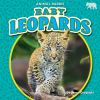-
-
2001., Coopper Beech Books Call No: 591.73 Availability:1 of 1 At Location(s) Series Title: Endangered and extinctSummary Note: Briefly describes a variety of animals, including lemurs, apes and monkeys, parrots, and elephants, which are endangered or already extinct as a result of man's destruction of their forest habitats or man's poaching and hunting.
-
-
Primary Call No: 599.75 541392 Edition: Bearcub books. Availability:1 of 1 At Location(s) Summary Note: "A baby leopard is born with its eyes closed. It cannot see anything. When the little cub is about one week old, it opens its eyes and looks around. Follow along with this leopard cub as it makes its way through the world. Watch it learn to swim, climb, and hunt. Then, it will be ready to live by itself. Simple text paired with adorable pictures helps build reading confidence for animal-loving early readers"--
-
-
c2012., Juvenile, Lerner Call No: 599.75 9 Availability:1 of 1 At Location(s) Series Title: Lightning bolt books. Animal look-alikesSummary Note: Photographs and text help readers decipher the differences between cheetahs and leopards, describing the physical features, behaviors, habitats, and other unique attributes of each species.
-
-
c2005., Juvenile, Crabtree Pub. Co. Call No: 599.75 54168 Availability:1 of 1 At Location(s) Series Title: Earth's endangered animals series
-
-
-- Wildlife atlasc1997., Facts on File Call No: 578 .09 Availability:1 of 1 At Location(s) Summary Note: Describes the different types of wildlife in the world and explains how and why each region has its own unique mix of creatures; focuses on habitats, evolution, migratory patterns, and danger of extinction.
-
-
2010., Juvenile, Scholastic Press Call No: 599.75 55 Edition: 1st ed. Availability:1 of 1 At Location(s)
-
-
2010., Juvenile, Scholastic Press Call No: 599.75 55 Edition: 1st ed. Availability:1 of 1 At Location(s) Summary Note: When Leo was less than seven weeks old, he became orphaned in the snowy Himalayan mountains in Pakistan. Rescued by a kind shepherd and his family, Leo eventually came to the world-famous Bronx Zoo in New York, the leading experts on caring for and breeding the critically endangered snow leopard.
-
-
By Ryndak, Robc2016., Primary, GARETH STEVENS PUBLISHING Call No: ENF 599.75 54 Availability:1 of 1 At Location(s) Series Title: GS leveled reader.Summary Note: Jungle cats can be tough to tell apart, but often it's the spots that give an animal away. With leopards and jaguars, knowing where the animal lives can be a big hint as to which cat is stalking its prey. Telling the two animals apart is easy once we take a closer look. Jaguars are heavier than leopards and their features are unique when you take a good look at their heads.
-
-
By Riggs, Kate2012., Primary, Creative Education Call No: 599.75 54 Edition: 1st ed. Availability:1 of 1 At Location(s) Series Title: Amazing animalsSummary Note: "A basic exploration of the appearance, behavior, and habitat of leopards, Earth's fourth- largest cats. Also included is a story from folklore explaining why leopards and baboons don't get along."--Provided by publisher.
-
-
c1995., Juvenile, Little, Brown Call No: 398.2 SOU Edition: 1st U.S. ed. Availability:1 of 1 At Location(s) Summary Note: Osebo the leopard has a magnificent drum that he won't share with anyone else, so Nayme, the Sky-God, offers a reward to the animal who will bring him the drum.
-
-
2008., Juvenile, Capstone Press Call No: 599.75 54096 Availability:1 of 1 At Location(s) Series Title: Pebble plus. African animals.Summary Note: Did you know that leopards lounge in tree branches? Discover how these wild cats live their lives in Africa.
-
-
c2003., Primary, Rourke Pub. Call No: 599.75 54 Availability:1 of 1 At Location(s) Series Title: Rourke discovery librarySummary Note: Photographs and text provide information about leopards, describing how they look, where and how they live, their hunting behaviors, and their adaptation to shrinking habitats.
-
-
By Squire, Annc2005., Juvenile, Children's Press Call No: 599.75 54 Availability:1 of 1 At Location(s) Series Title: A true book.
-
-
2005., Gareth Stevens Pub. Call No: 599.75 54139 Availability:1 of 1 At Location(s) Series Title: Born to be wild
-
-
c2008., MyReportLinks.com Books Call No: 599.75 55 Availability:1 of 1 At Location(s)Table of contents Series Title: Saving endangered speciesSummary Note: Presents information on snow leopards, discusses their habitat, threats to their survival, and efforts to save the species, and includes Web site links throughout.
-
-
c1998., The Child's World Call No: 599.75 55 Availability:1 of 1 At Location(s) Summary Note: Describes the physical characteristics, behavior, habitat, and life cycle of snow leopards.
-
-
c2010., Pre-adolescent, Enslow Elementary Call No: 599.75 54 Availability:1 of 1 At Location(s)View cover image provided by Mackin Series Title: Animals of the snow and iceSummary Note: Provides information about snow leopards, covering topics such as their habitat, eating habits, mating, and physical characteristics, and discusses their endangered status and conservation measures that are being taken.
-
-
2014., Children's Press, an imprint of Scholastic Inc Call No: 599.75 Availability:1 of 1 At Location(s) Series Title: Nature's childrenSummary Note: "Rarely seen by human eyes, the elusive snow leopard prowls the rocky cliffs of its mountain home in search of prey. Readers will discover why this fascinating cat is so hard to find, how it survives in the freezing temperatures of its habitat, and what it has in common with other large cats. They will also find out why snow leopards move up and down mountains as the seasons change and how they protect their cubs from harm."--
-
-
c2011., Juvenile, Capstone Press Call No: 599.75 55 Availability:1 of 1 At Location(s) Series Title: WildcatsSummary Note: Simple text and full-color photos explain the habitat, life cycle, range, and behavior of snow leopards
-
-
c2013, Juvenile, Charlesbridge Call No: 599.75 55 Availability:1 of 1 At Location(s) Summary Note: "Outside the den it's a dangerous world. ... Be quiet when you go hunting." High in Pakistan's Hindu Kush Mountains, young twin snow leopards learn their mother's lessons for survival.





















